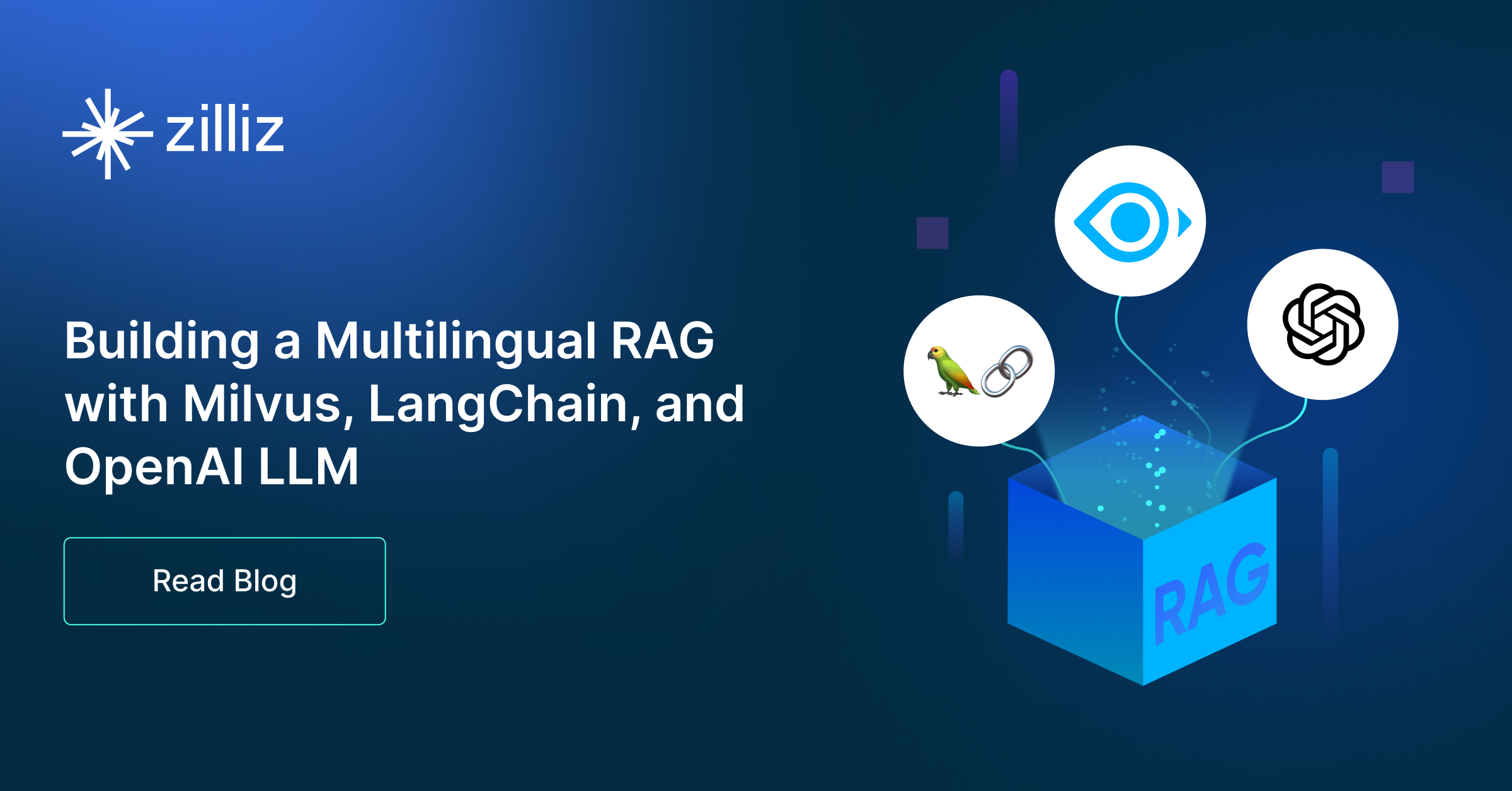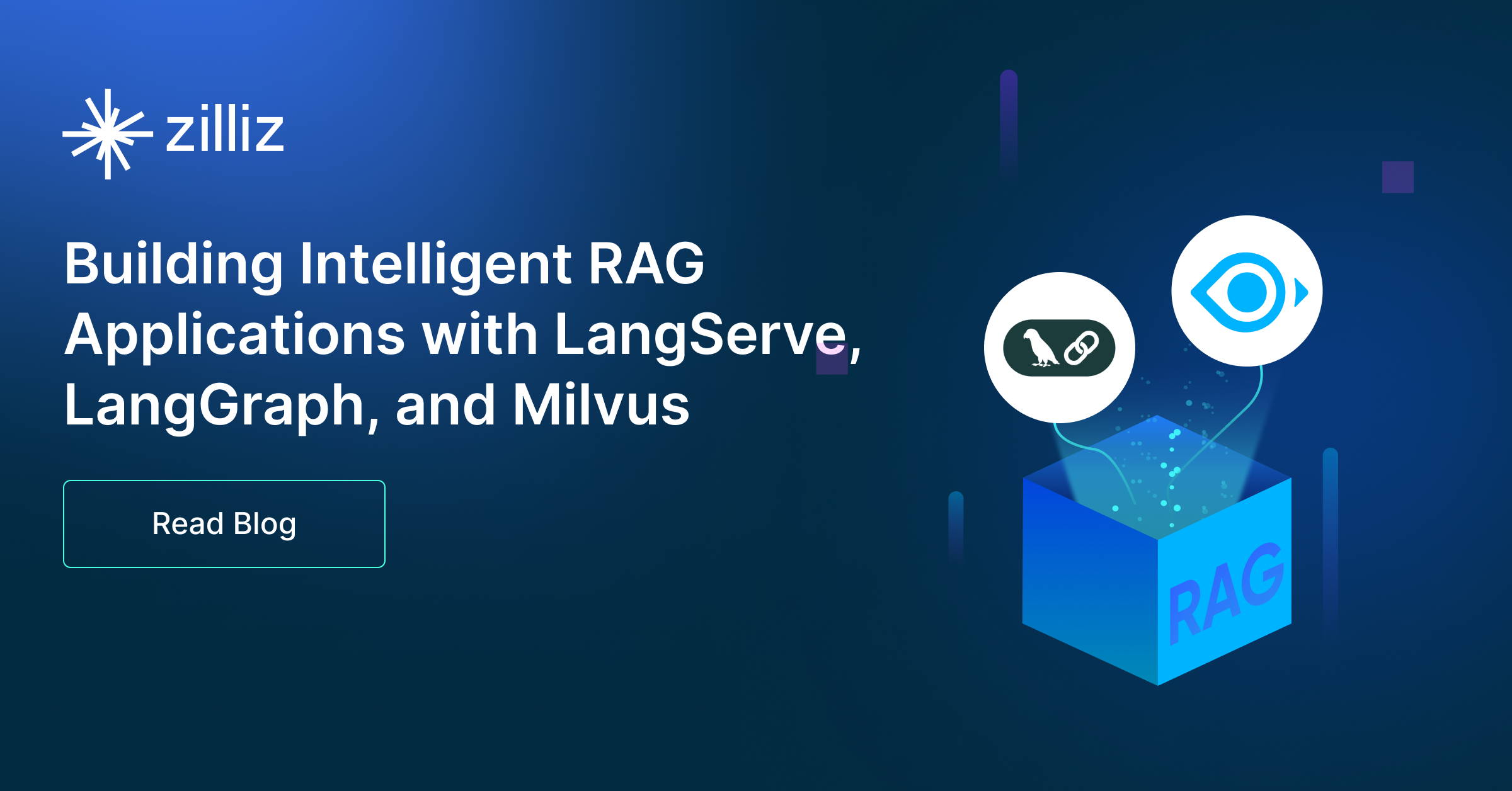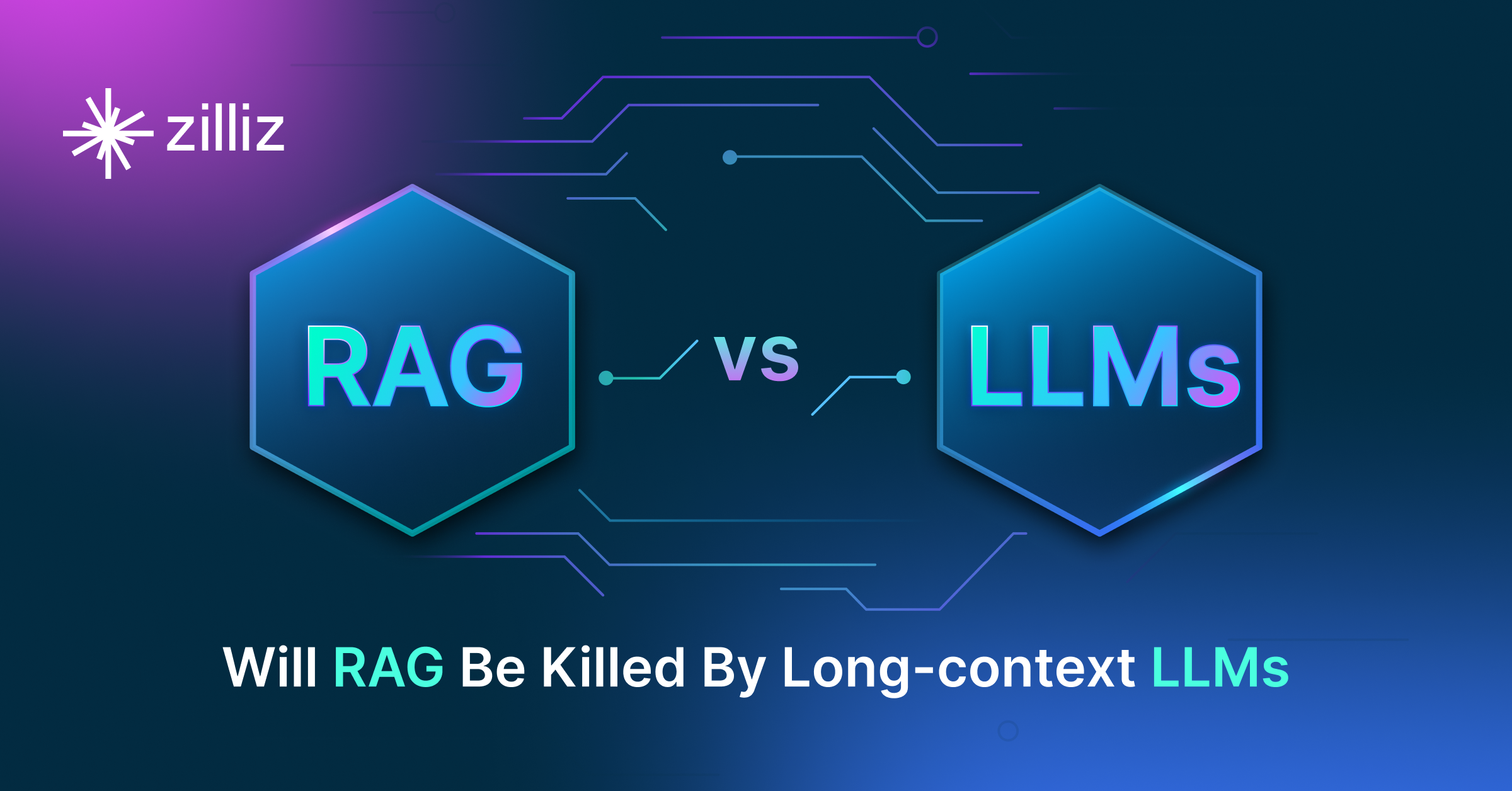Build RAG Chatbot with LangChain, Milvus, Google Vertex AI Gemini 2.0 Flash-Lite, and Cohere embed-multilingual-light-v3.0
Introduction to RAG
Retrieval-Augmented Generation (RAG) is a game-changer for GenAI applications, especially in conversational AI. It combines the power of pre-trained large language models (LLMs) like OpenAI’s GPT with external knowledge sources stored in vector databases such as Milvus and Zilliz Cloud, allowing for more accurate, contextually relevant, and up-to-date response generation. A RAG pipeline usually consists of four basic components: a vector database, an embedding model, an LLM, and a framework.
Key Components We'll Use for This RAG Chatbot
This tutorial shows you how to build a simple RAG chatbot in Python using the following components:
- LangChain: An open-source framework that helps you orchestrate the interaction between LLMs, vector stores, embedding models, etc, making it easier to integrate a RAG pipeline.
- Milvus: An open-source vector database optimized to store, index, and search large-scale vector embeddings efficiently, perfect for use cases like RAG, semantic search, and recommender systems. If you hate to manage your own infrastructure, we recommend using Zilliz Cloud, which is a fully managed vector database service built on Milvus and offers a free tier supporting up to 1 million vectors.
- Google Vertex AI Gemini 2.0 Flash-Lite: This model streamlines AI deployment with an emphasis on low-latency and cost-efficient solutions. It excels in real-time applications like chatbots and interactive tools, combining high performance with seamless integration across various frameworks. Ideal for businesses looking to enhance user engagement without compromising efficiency.
- Cohere embed-multilingual-light-v3.0: This model is designed for efficient multilingual text embedding, enabling robust semantic search and similarity tasks across various languages. It excels in scenarios requiring rapid comprehension and matching of diverse linguistic datasets, making it ideal for global applications in content recommendation, categorization, and cross-language information retrieval.
By the end of this tutorial, you’ll have a functional chatbot capable of answering questions based on a custom knowledge base.
Note: Since we may use proprietary models in our tutorials, make sure you have the required API key beforehand.
Step 1: Install and Set Up LangChain
%pip install --quiet --upgrade langchain-text-splitters langchain-community langgraph
Step 2: Install and Set Up Google Vertex AI Gemini 2.0 Flash-Lite
pip install -qU "langchain[google-vertexai]"
# Ensure your VertexAI credentials are configured
from langchain.chat_models import init_chat_model
llm = init_chat_model("gemini-1.5-flash", model_provider="google_vertexai")
Step 3: Install and Set Up Cohere embed-multilingual-light-v3.0
pip install -qU langchain-cohere
import getpass
import os
if not os.environ.get("COHERE_API_KEY"):
os.environ["COHERE_API_KEY"] = getpass.getpass("Enter API key for Cohere: ")
from langchain_cohere import CohereEmbeddings
embeddings = CohereEmbeddings(model="embed-multilingual-light-v3.0")
Step 4: Install and Set Up Milvus
pip install -qU langchain-milvus
from langchain_milvus import Milvus
vector_store = Milvus(embedding_function=embeddings)
Step 5: Build a RAG Chatbot
Now that you’ve set up all components, let’s start to build a simple chatbot. We’ll use the Milvus introduction doc as a private knowledge base. You can replace it with your own dataset to customize your RAG chatbot.
import bs4
from langchain import hub
from langchain_community.document_loaders import WebBaseLoader
from langchain_core.documents import Document
from langchain_text_splitters import RecursiveCharacterTextSplitter
from langgraph.graph import START, StateGraph
from typing_extensions import List, TypedDict
# Load and chunk contents of the blog
loader = WebBaseLoader(
web_paths=("https://milvus.io/docs/overview.md",),
bs_kwargs=dict(
parse_only=bs4.SoupStrainer(
class_=("doc-style doc-post-content")
)
),
)
docs = loader.load()
text_splitter = RecursiveCharacterTextSplitter(chunk_size=1000, chunk_overlap=200)
all_splits = text_splitter.split_documents(docs)
# Index chunks
_ = vector_store.add_documents(documents=all_splits)
# Define prompt for question-answering
prompt = hub.pull("rlm/rag-prompt")
# Define state for application
class State(TypedDict):
question: str
context: List[Document]
answer: str
# Define application steps
def retrieve(state: State):
retrieved_docs = vector_store.similarity_search(state["question"])
return {"context": retrieved_docs}
def generate(state: State):
docs_content = "\n\n".join(doc.page_content for doc in state["context"])
messages = prompt.invoke({"question": state["question"], "context": docs_content})
response = llm.invoke(messages)
return {"answer": response.content}
# Compile application and test
graph_builder = StateGraph(State).add_sequence([retrieve, generate])
graph_builder.add_edge(START, "retrieve")
graph = graph_builder.compile()
Test the Chatbot
Yeah! You've built your own chatbot. Let's ask the chatbot a question.
response = graph.invoke({"question": "What data types does Milvus support?"})
print(response["answer"])
Example Output
Milvus supports various data types including sparse vectors, binary vectors, JSON, and arrays. Additionally, it handles common numerical and character types, making it versatile for different data modeling needs. This allows users to manage unstructured or multi-modal data efficiently.
Optimization Tips
As you build your RAG system, optimization is key to ensuring peak performance and efficiency. While setting up the components is an essential first step, fine-tuning each one will help you create a solution that works even better and scales seamlessly. In this section, we’ll share some practical tips for optimizing all these components, giving you the edge to build smarter, faster, and more responsive RAG applications.
LangChain optimization tips
To optimize LangChain, focus on minimizing redundant operations in your workflow by structuring your chains and agents efficiently. Use caching to avoid repeated computations, speeding up your system, and experiment with modular design to ensure that components like models or databases can be easily swapped out. This will provide both flexibility and efficiency, allowing you to quickly scale your system without unnecessary delays or complications.
Milvus optimization tips
Milvus serves as a highly efficient vector database, critical for retrieval tasks in a RAG system. To optimize its performance, ensure that indexes are properly built to balance speed and accuracy; consider utilizing HNSW (Hierarchical Navigable Small World) for efficient nearest neighbor search where response time is crucial. Partitioning data based on usage patterns can enhance query performance and reduce load times, enabling better scalability. Regularly monitor and adjust cache settings based on query frequency to avoid latency during data retrieval. Employ batch processing for vector insertions, which can minimize database lock contention and enhance overall throughput. Additionally, fine-tune the model parameters by experimenting with the dimensionality of the vectors; higher dimensions can improve retrieval accuracy but may increase search time, necessitating a balance tailored to your specific use case and hardware infrastructure.
Google Vertex AI Gemini 2.0 Flash-Lite optimization tips
Gemini 2.0 Flash-Lite is a lightweight, fast-response model suited for cost-efficient RAG applications. Improve retrieval by using high-precision embeddings to minimize irrelevant context. Structure prompts efficiently, keeping them short and well-organized. Adjust temperature (0.1–0.2) for accuracy, tuning top-p for output variety when needed. Cache frequent queries to reduce API usage and improve performance. Use Google’s auto-scaling infrastructure to handle demand spikes seamlessly. If deploying multiple models, utilize Flash-Lite for initial filtering and summarization while reserving larger models for in-depth reasoning.
Cohere embed-multilingual-light-v3.0 optimization tips
Cohere embed-multilingual-light-v3.0 is optimized for faster and more efficient multilingual embeddings. Reduce input data size by filtering out non-essential elements and focusing on key phrases or terms that provide the most value in cross-lingual search scenarios. Implement approximate nearest neighbor search methods, such as FAISS, to ensure that retrieval remains fast and accurate even in large datasets. Use vector compression techniques to save on storage space while maintaining retrieval quality. Employ caching strategies to store commonly used embeddings and reduce unnecessary recomputation. Optimize search performance by organizing embeddings into a hierarchical structure based on languages or topics, enabling quicker retrieval from specific language groups.
By implementing these tips across your components, you'll be able to enhance the performance and functionality of your RAG system, ensuring it’s optimized for both speed and accuracy. Keep testing, iterating, and refining your setup to stay ahead in the ever-evolving world of AI development.
RAG Cost Calculator: A Free Tool to Calculate Your Cost in Seconds
Estimating the cost of a Retrieval-Augmented Generation (RAG) pipeline involves analyzing expenses across vector storage, compute resources, and API usage. Key cost drivers include vector database queries, embedding generation, and LLM inference.
RAG Cost Calculator is a free tool that quickly estimates the cost of building a RAG pipeline, including chunking, embedding, vector storage/search, and LLM generation. It also helps you identify cost-saving opportunities and achieve up to 10x cost reduction on vector databases with the serverless option.
 Calculate your RAG cost
Calculate your RAG cost
What Have You Learned?
What have we learned throughout this enriching tutorial? We’ve ventured into the exciting intersection of technology and innovation, equipping ourselves with powerful tools to build a cutting-edge Retrieval-Augmented Generation (RAG) system. By diving into LangChain as our seamless framework, we discovered how it elegantly weaves together all the components, making it the backbone of our system and allowing for smooth integration.
Utilizing Milvus, we learned how to leverage a vector database that powers incredibly fast searches, ensuring that our applications can retrieve relevant information at lightning speed, no matter the size of our dataset. We then saw how Google Vertex AI Gemini 2.0 Flash-Lite, our LLM, breathes conversational intelligence into our projects, enabling dynamic and engaging interactions that feel natural and intuitive. Finally, with the embedding model from Cohere, we created rich semantic representations that not only enhance understanding but also add depth to our queries and responses.
Along the way, we shared optimization tips and even provided a free cost calculator, empowering you to manage resources effectively. Now, as you stand on the brink of innovation, I encourage you to roll up your sleeves and start building! Experiment, optimize, and let your creativity run wild. The possibilities are endless, and with the knowledge you’ve gained, you’re more than ready to forge your path in developing powerful RAG applications. Go ahead and make your mark!
Further Resources
🌟 In addition to this RAG tutorial, unleash your full potential with these incredible resources to level up your RAG skills.
- How to Build a Multimodal RAG | Documentation
- How to Enhance the Performance of Your RAG Pipeline
- Graph RAG with Milvus | Documentation
- How to Evaluate RAG Applications - Zilliz Learn
- Generative AI Resource Hub | Zilliz
We'd Love to Hear What You Think!
We’d love to hear your thoughts! 🌟 Leave your questions or comments below or join our vibrant Milvus Discord community to share your experiences, ask questions, or connect with thousands of AI enthusiasts. Your journey matters to us!
If you like this tutorial, show your support by giving our Milvus GitHub repo a star ⭐—it means the world to us and inspires us to keep creating! 💖
- Introduction to RAG
- Key Components We'll Use for This RAG Chatbot
- Step 1: Install and Set Up LangChain
- Step 2: Install and Set Up Google Vertex AI Gemini 2.0 Flash-Lite
- Step 3: Install and Set Up Cohere embed-multilingual-light-v3.0
- Step 4: Install and Set Up Milvus
- Step 5: Build a RAG Chatbot
- Optimization Tips
- RAG Cost Calculator: A Free Tool to Calculate Your Cost in Seconds
- What Have You Learned?
- Further Resources
- We'd Love to Hear What You Think!
Content
Vector Database at Scale
Zilliz Cloud is a fully-managed vector database built for scale, perfect for your RAG apps.
Try Zilliz Cloud for Free


